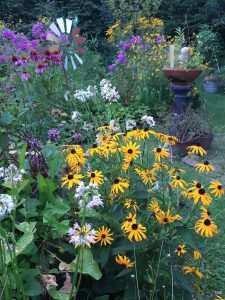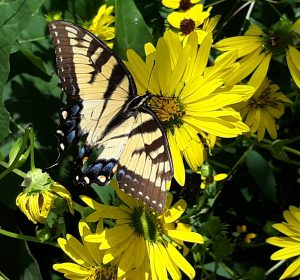Plant a Little Prairie: How to Grow a Microprairie in Your Yard
By Laura Walther Schaefer
Microprairies are exactly as they sound- miniature versions of our grand prairies. They can occupy as little or as much space as you have or desire. Because they are prairies, they should be planted in a full sun environment that receives at least 6 hours of direct sunlight per day.

Why consider planting a microprairie? We live in the prairie state, yet only .01% of our native prairies remain. Eighty five percent of the land in the US is privately owned and that land includes around double the amount of acreage in lawn than we have in National Parks in the lower 48 states. We have so much land and so little in protected habitat. In addition, 90% of our plant eating insects rely on native foods, while 96% of our native birds rely on those insects (and spiders) to feed and raise their young. No native plants, no native insects, no native birds. It’s that simple. If we want songbirds to be around in the future, we must learn to love spiders and bugs. And those are just two members in the complex web of life. If you’re familiar with the entomologist and author, Douglas Tallamy, you may have heard of the story of observing a chickadee bringing caterpillars back to feed their babies. It takes 16-18 days to raise a clutch of baby chickadees. It takes 350-570 caterpillars per day to raise that clutch, which comes to a total of 6,000-9,000 caterpillars needed to raise just one nest of baby chickadees! Where will all that food come from if not from our efforts? In addition to local populations of organisms that depend on native plants, either directly or indirectly for food, there are migrating populations of birds, butterflies and even some dragonflies that need insects or nectar along their flight to wintering grounds. Having a little prairie offers energy for them to refuel along their trip. If everyone planted just part of their yards in native plants, we could create a food & shelter corridor back and forth from wintering to breeding grounds.
Where to begin? Start by locating a sunny spot in your yard. Assuming this area is in lawn you will then need to kill or remove the grass. This can be achieved by many means. If it’s still warm and sunny you can cover the area with a sheet of clear plastic. This will bake the plants below. Another method of killing grass is to use an herbicide. A mechanical means to removing grass would be to use a sod cutter or spade and lastly, my favorite method of creating new planting beds is to collect cardboard (or lots of newspaper) lay it down and top the cardboard with several inches of compost (if using seed) or grass clippings or wood mulch (if using plants). With seed and the cardboard plus compost method, you can plant immediately. In time the cardboard will decompose. If using another method, once your grass is killed you don’t need to remove the dead material as it will stabilize the soil while your seedlings grow and keep seed from washing away.

Planting: If you are using plants and the cardboard method, you simply puncture through the cardboard and plant or if another method, wait for the grass to die before planting and then mulch around your new plants. The mulch will protect them from winter frost heaving that could uproot a plant. Make sure to water your new plants if we aren’t getting weekly rains of about an inch. If you are using seed you will want to have the site prepared this fall as it is the best time for preparing a bed for native prairie seeds. Most native plant seeds need to go through the process of cold-moist stratification. Stratification is necessary to break dormancy and get a seed to germinate. The cold and moist period depends on the species, but I would plan for needing 90 days of cold and precipitation. I like to scatter my native seeds by early December. If you wait until spring to plant native seeds you will see little germination. The freezing and thawing cycles of the soil will create nooks and crannies for your seed to make contact with the soil. If the soil appears fairly smooth, rough it up with a garden rake before broadcasting your seed. There’s no need to water your seeds upon planting. Nature will take care of it.
What to choose? Try to pick at least 5 different kinds of plants and grasses that bloom at varying times so that there is always something available for pollen and nectar. Pick species that are compatible to your soil type and moisture level. Plan for anywhere from 16 inches to 2 feet between plants. Here’s one combination, in order of bloom time; from spring to fall: Penstemon, Coreopsis, Purple Coneflower, Butterflyweed and finish the summer off with an Aster or Goldenrod. Add Little Bluestem or Prairie Dropseed for a grass. I would recommend at a minimum 3 plants of each species planted together.
Sources: Check your local nursery to see if they sell the Missouri Prairie Foundation’s Grow Native plants that come in purple pots. Effinger’s Nursery in Belleville has the Grow Native plants available for sale. Avoid cultivars of natives as they are typically less attractive to our native insects. For mail order, I use and recommend Missouri Wildflower Nursery (mowildflowers.net) and Prairie Moon Nursery (prairiemoon.com). Prairie Moon has a fabulous catalog and website full of information on size, bloom time, germination codes, soil types, deer dislike or what it attracts (insects, hummingbirds, native bees). They also have a filter tool on their website that allows you to narrow down options by the parameters you choose. Prairie Moon also sells seed mixes so you can buy one that suits your soil types, space or other needs. In the spring, they sell plants in plugs and in fall they sell plants in pots and as bareroot plants.

If this year is too soon for you to get ready, but you’re interested in knowing more, I recommend spending some winter reading time with either of Tallamy’s books- Bringing Nature Home or Nature’s Best Hope. I would also recommend the books, Pollinators of Native Plants and The Humane Gardener (also a blog and Facebook page). Another great Facebook page which focuses on using native plants in your landscape is Gardening with Nature in Mind. A wonderful resource that I often use to help identify plants, find if they’re native to my county, what habitat to find them in and what they attract is illinoiswildflowers.info.
I hope you will consider joining me in creating native plant spaces for wildlife in your yard. I find endless joy in watching all of the diverse organism and their interactions that I now see in my yard that I would not have if I had kept in all in lawn. I’ll end with the words of Douglas W. Tallamy, because after all, “We are nature’s best hope.”
CLIFFTOP, a local nonprofit organization, is focused on preserving and protecting area bluff lands.
A versionof this article appeared in the September 18, 2020 edition of the Monroe County Independent.
©2020 all content rights reserved Clifftop NFP.
Comments are currently closed.
